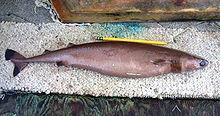Cookiecutter shark
| Cookiecutter shark | |
|---|---|
 |
|
| Scientific classification | |
| Kingdom: | Animalia |
| Phylum: | Chordata |
| Class: | Chondrichthyes |
| Order: | Squaliformes |
| Family: | Dalatiidae |
| Genus: | Isistius |
| Species: | I. brasiliensis |
| Binomial name | |
|
Isistius brasiliensis (Quoy & Gaimard, 1824) |
|
 |
|
| Range of the cookiecutter shark | |
| Synonyms | |
|
Isistius labialis Meng, Chu & Li, 1985 |
|
Isistius labialis Meng, Chu & Li, 1985
Leius ferox Kner, 1864
Scymnus brasiliensis Quoy & Gaimard, 1824
Scymnus torquatus Müller & Henle, 1839
Scymnus unicolor Müller & Henle, 1839
Squalus fulgens Bennett, 1840
Cookiecutter shark (Isistius brasiliensis), also called the cigar shark, is a species of small dogfish shark in the family Dalatiidae. This shark occurs in warm, oceanic waters worldwide, particularly near islands, and has been recorded as deep as 3.7 km (2.3 mi). It migrates vertically up to 3 km (1.9 mi) every day, approaching the surface at dusk and descending with the dawn. Reaching only 42–56 cm (16.5–22 in) in length, the cookiecutter shark has a long, cylindrical body with a short, blunt snout, large eyes, two tiny spineless dorsal fins, and a large caudal fin. It is dark brown, with light-emitting photophores covering its underside except for a dark "collar" around its throat and gill slits.
The name "cookiecutter shark" refers to its feeding habit of gouging round plugs, as if cut out with a cookie cutter, out of larger animals. Marks made by cookiecutter sharks have been found on a wide variety of marine mammals and fishes, as well as on submarines, undersea cables, and even human bodies. It also consumes whole smaller prey such as squid. Cookiecutter sharks have adaptations for hovering in the water column and likely rely on stealth and subterfuge to capture more active prey. Its dark collar seems to mimic the silhouette of a small fish, while the rest of its body blends into the downwelling light via its ventral photophores. When a would-be predator approaches the lure, the shark attaches itself using its suctorial lips and specialized pharynx and neatly excises a chunk of flesh using its bandsaw-like set of lower teeth. This species has been known to travel in schools.
...
Wikipedia

